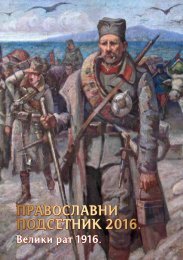Zajecar - engleski - niska rezolucija
Create successful ePaper yourself
Turn your PDF publications into a flip-book with our unique Google optimized e-Paper software.
HISTORY<br />
19<br />
(state), one out of 21 in Serbia at that time.<br />
The first doctors arrive to Timočka krajina:<br />
self-taught Sa va Jo va no vić, doctor Re brić<br />
(Master of Science in surgery), and later doctor<br />
Bi he le (with degrees in medicine and veterinary<br />
sciences).<br />
1836. The first high school and gymnasium<br />
was opened in Zaječar, only three years after<br />
at that time the only Serbian gymnasium in<br />
Kra gu jev ac. 29 craftsmen are working in the<br />
city (three tailors making traditional clothes,<br />
nine other tailors, eight craftsmen making<br />
leather apparel, craftsmen painting textile,<br />
two bag makers) and 21 taverns. Zaječar fair<br />
was established.<br />
1839. The seat of Eparchy was moved from<br />
Zaječar to Ne go tin. That same year, Zaječar<br />
gymnasium was also moved to Ne go tin.<br />
1843. The first post office was opened in<br />
Zaječar, third class branch. Di mi tri je Ka pa ris,<br />
born in Epirus, became the first permanent<br />
doctor in the city (on September 16).<br />
1845. Ba ron Zig mund Av gust Her der, a Saxon<br />
royal mining governor, in his book Mining<br />
Road Through Serbia, provides the first modern<br />
description and professional assessment<br />
of ancient remains in Gam zi gra d. Merchant<br />
Mi len ko Ste va no vić was the first person who<br />
enabled people from Zaječar to buy books at<br />
his store.<br />
1853. Schools were opened in Za gra đe, Vr bica,<br />
Lub ni ca and Ve li ki Iz vo r.<br />
1855. A school was opened in Zve zda n. Female<br />
elementary school began to work in Zaje<br />
ča r, led by Eka ta ri na Ko stić from Ko vi n.<br />
1856. Upon a decree of district chief Alek sandar<br />
N. Tr fi ko vi ć, the cobbling of streets began<br />
and Za je čar soon began to look like a “true<br />
city”. The first hospital and the first bookstore<br />
were opened.<br />
1860. Austrian archaeologist and travel<br />
writer Felix Ka nic stayed in Gam zi gra d,<br />
made drawings of then visible wall and the<br />
Ra dul-be g’s Residence, a part of exhibition “The Old Za je čar”, 19 th century

















